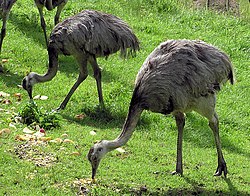

This article lists living orders and families of birds. In total there are about 11,000 species of birds described as of 2024, [1] though one estimate of the real number places it at almost 20,000. [2] The order passerines (perching birds) alone accounts for well over 5,000 species.
Contents
- Phylogeny
- Subclass Palaeognathae
- Order Struthioniformes
- Infraclass Notopalaeognathae
- Subclass Neognathae
- Infraclass Galloanserae
- Infraclass Neoaves
- See also
- References
Taxonomy is very fluid in the age of DNA analysis, so comments are made where appropriate, and all numbers are approximate. In particular see Sibley-Ahlquist taxonomy for a very different classification.



































